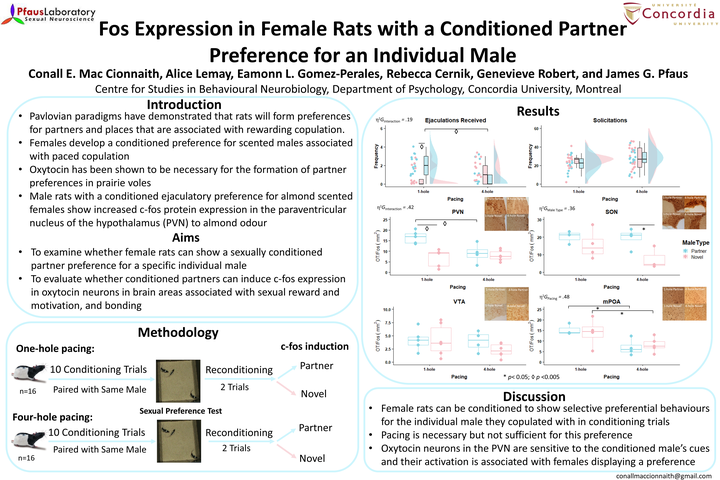Fos expression in female rats with a conditioned partner preference for an individual male

Conall E. Mac Cionnaith, Alice Lemay, Eamonn Gomez-Perales, Genevieve Robert, Rebecca Cernik and James G. Pfaus
Presented at Society for Neuroscience 2018 San Diego
Accepted abstract A growing body of evidence shows important roles of Pavlovian learning in sexual partner selection. Female rats who repeatedly undergo paced copulation with almond scented males selectively solicit, and preferentially receive the scented male’s ejaculations relative to those of an unscented male. Exposure to conditioned scented partner cues has been shown to induce Fos protein within oxytocin (OT) neurons in the paraventricular nucleus (PVN) of the hypothalamus. Whether female rats can be conditioned to show a partner preference for an individual male rat has not yet been shown. The aim of this study was to test whether female rats could form a conditioned preference for an individual male rat. Females were given paced copulation with either a one-hole divider or a fourhole divider in a unilevel pacing chamber but always copulated with the same partner during conditioning trials (N = 32). After 10 trials, females were then given an open-field partner preference test with the partner male and a novel male. Females underwent two reconditioning trials and were then exposed to the partner or a novel male for an hour to induce Fos protein, after which we examined regions of the brain associated with incentive motivation, sexual behaviour, and bonding (nucleus accumbens core and shell, medial preoptic area, and ventral tegmental area). Fos protein was also examined in OT-labelled neurons within the PVN and supraoptic nucleus (SON). Behavioural results indicated that females in the one-hole pacing group received the first ejaculation more frequently and more ejaculations overall from the partner male compared to the novel male. The four-hole pacing group did not display a conditioned partner preference. Preliminary counts in the PVN (n = 3) did not show a significant difference in Fos/OT co-labelled cells, but, there is a trend toward an interaction between the male females were exposed to and the pacing group (p < .10, η²p =.141). Preliminary result suggest this interaction is being driven by increased activation in females in the one-hole group exposed to the partner male. The behavioural data suggest that pacing is necessary but not sufficient for the formation of conditioned partner preference for an individual male rat. We expect that exposure to the partner in the one-hole pacing will show differential Fos expression compared to females exposed to a novel male and will not be present in the four-hole group. If this effect is found it would suggest that activation of OT cells in the PVN are likely involved in the display of conditioned partner preference for individual male rats as well as for conditioned odour cues.